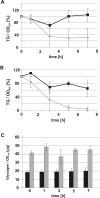A Yeast Mutant Deleted of GPH1 Bears Defects in Lipid Metabolism
- PMID: 26327557
- PMCID: PMC4556709
- DOI: 10.1371/journal.pone.0136957
A Yeast Mutant Deleted of GPH1 Bears Defects in Lipid Metabolism
Abstract
In a previous study we demonstrated up-regulation of the yeast GPH1 gene under conditions of phosphatidylethanolamine (PE) depletion caused by deletion of the mitochondrial (M) phosphatidylserine decarboxylase 1 (PSD1) (Gsell et al., 2013, PLoS One. 8(10):e77380. doi: 10.1371/journal.pone.0077380). Gph1p has originally been identified as a glycogen phosphorylase catalyzing degradation of glycogen to glucose in the stationary growth phase of the yeast. Here we show that deletion of this gene also causes decreased levels of phosphatidylcholine (PC), triacylglycerols and steryl esters. Depletion of the two non-polar lipids in a Δgph1 strain leads to lack of lipid droplets, and decrease of the PC level results in instability of the plasma membrane. In vivo labeling experiments revealed that formation of PC via both pathways of biosynthesis, the cytidine diphosphate (CDP)-choline and the methylation route, is negatively affected by a Δgph1 mutation, although expression of genes involved is not down regulated. Altogether, Gph1p besides its function as a glycogen mobilizing enzyme appears to play a regulatory role in yeast lipid metabolism.
Conflict of interest statement
Figures









Similar articles
-
From yeast to humans - roles of the Kennedy pathway for phosphatidylcholine synthesis.FEBS Lett. 2018 Apr;592(8):1256-1272. doi: 10.1002/1873-3468.12919. Epub 2017 Dec 19. FEBS Lett. 2018. PMID: 29178478 Review.
-
Regulatory link between steryl ester formation and hydrolysis in the yeast Saccharomyces cerevisiae.Biochim Biophys Acta. 2015 Jul;1851(7):977-86. doi: 10.1016/j.bbalip.2015.02.011. Epub 2015 Feb 24. Biochim Biophys Acta. 2015. PMID: 25720564
-
Transcriptional response to deletion of the phosphatidylserine decarboxylase Psd1p in the yeast Saccharomyces cerevisiae.PLoS One. 2013 Oct 11;8(10):e77380. doi: 10.1371/journal.pone.0077380. eCollection 2013. PLoS One. 2013. PMID: 24146988 Free PMC article.
-
Functional redundancy of CDP-ethanolamine and CDP-choline pathway enzymes in phospholipid biosynthesis: ethanolamine-dependent effects on steady-state membrane phospholipid composition in Saccharomyces cerevisiae.J Bacteriol. 1994 Nov;176(22):6861-8. doi: 10.1128/jb.176.22.6861-6868.1994. J Bacteriol. 1994. PMID: 7961445 Free PMC article.
-
Phosphatidylcholine and the CDP-choline cycle.Biochim Biophys Acta. 2013 Mar;1831(3):523-32. doi: 10.1016/j.bbalip.2012.09.009. Epub 2012 Sep 23. Biochim Biophys Acta. 2013. PMID: 23010477 Free PMC article. Review.
Cited by
-
Energy Storage in Yeast: Regulation and Competition with Ethanol Production.Curr Microbiol. 2016 Dec;73(6):851-858. doi: 10.1007/s00284-016-1127-4. Epub 2016 Sep 12. Curr Microbiol. 2016. PMID: 27620384
-
A TAL effector-like protein of an endofungal bacterium increases the stress tolerance and alters the transcriptome of the host.Proc Natl Acad Sci U S A. 2020 Jul 21;117(29):17122-17129. doi: 10.1073/pnas.2003857117. Epub 2020 Jul 6. Proc Natl Acad Sci U S A. 2020. PMID: 32632014 Free PMC article.
-
Accumulation of Glycogen and Upregulation of LEA-1 in C. elegans daf-2(e1370) Support Stress Resistance, Not Longevity.Cells. 2022 Jan 12;11(2):245. doi: 10.3390/cells11020245. Cells. 2022. PMID: 35053361 Free PMC article.
References
-
- Athenstaedt K, Daum G. Tgl4p and Tgl5p, two triacylglycerol lipases of the yeast Saccharomyces cerevisiae are localized to lipid particles J. Biol. Chem. 2005; 280: 37301–37309. - PubMed
-
- Daum G, Lees ND, Bard M, Dickson R. Biochemistry, cell biology and molecular biology of lipids of Saccharomyces cerevisiae , Yeast. 1998; 14: 1471–1510. - PubMed
-
- Carman GM, Henry SA. Phospholipid biosynthesis in the yeast Saccharomyces cerevisiae and interrelationship with other metabolic processes, Prog Lipid Res. 1999; 38: 361–399. - PubMed
Publication types
MeSH terms
Substances
Grants and funding
LinkOut - more resources
Full Text Sources
Other Literature Sources
Molecular Biology Databases

